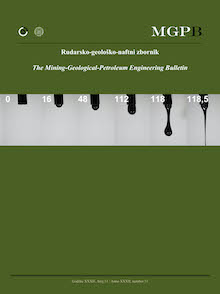The application of a stockpile stochastic model into long-term open pit mine production scheduling to improve the feed grade for the processing plant
DOI:
https://doi.org/10.17794/rgn.2020.4.10Keywords:
open pit long-term production scheduling (OPLTPS), stockpile management, linear programming (LP), mine planning, stochastic modelAbstract
This paper presents a chance-constrained integer programming approach based on linear method to solve the long-term open pit mine production scheduling problem. Specifically, a single stockpile has been addressed for storing excess low-grade material based on availability of processing capacity and for possible future processing. The proposed scheduling model maximizes the project NPV while respecting a series of physical and economic constraints. Differently from common practice, where deterministic models are used to calculate the average grade for material in the stockpiles, in this work a stochastic approach was performed, starting from the time of planning before the stockpile realization. By performing the probability analysis on two case studies (an iron and a gold deposits), it was proved that the stockpile attributes can be treated as normally distributed random variables. Afterwards, the stochastic programming model was formulated in an open pit gold mine in order to determine the optimum amount of ore dispatched from different bench levels in open pit and at the same time a low-grade stockpile to the mill. The chance-constrained programming was finally applied to obtain the equivalent deterministic solution of the primary model. The results obtained have showed a better feed grade for the processing plant with a higher NPV and probability of grade blending constraint satisfaction, with respect of using the traditional stockpile deterministic model. This paper presents a chance-constrained integer programming approach based on the linear method to solve the longterm open pit mine production scheduling problem. Specifically, a single stockpile has been addressed for storing excess low-grade material based on the availability of processing capacity and for possible future processing. The proposed scheduling model maximizes the project NPV while respecting a series of physical and economic constraints. Differently from common practice, where deterministic models are used to calculate the average grade for material in the stockpiles, in this work a stochastic approach was performed, starting from the time of planning before the stockpile realization. By performing a probability analysis on two case studies (on iron and gold deposits), it was proven that the stockpile attributes can be treated as normally distributed random variables. Afterwards, the stochastic programming model was formulated in an open pit gold mine in order to determine the optimum amount of ore dispatched from different bench levels in the open pit and at the same time a low-grade stockpile to the mill. The chance-constrained programming was finally applied to obtain the equivalent deterministic solution of the primary model. The obtained results have shown a better feed grade for the processing plant with a higher NPV and probability of grade blending constraint satisfaction, with respect to using the traditional stockpile deterministic model.
Downloads
Published
How to Cite
Issue
Section
License
Copyright (c) 2020 authors and journal

This work is licensed under a Creative Commons Attribution 4.0 International License.
Creative Commons-BY
Authors who publish with this journal agree to the following terms:
In agreeing this form, you certify that:
- You read the ethical codex of the RGN zbornik available at journal web.
- You submitted work is your original work, and has not previously been published and does not include any form of plagiarism.
- You own copyright in the submitted work, and are therefore permitted to assign the licence to publish to RGN zbornik.
- Your submitted work contains no violation of any existing copyright or other third party right or any material of an obscene, libellous or otherwise unlawful nature.
- You have obtained permission for and acknowledged the source of any illustrations, diagrams or other material included in the work of which you are not the copyright owner.
- You have taken due care to ensure the accuracy of the work, and that, to the best of your knowledge, there are no false statements made within it.
- All co-authors of this submitted work are aware of, and in agreement with, the terms of this licence and that the submitted manuscript has been approved by these authors.
Publication licence
You retain copyright in your submitted work, according to journal license policy (CC-BY). By signing this form you agree that RGN zbornik may publish it under the publication licence. In summary the licence allows the following:
Anyone is free:
- To copy, distribute, display, and perform the work.
- To make derivative works.
Under the following conditions:
- The original author must always be given credit.
- The work may not be used for commercial purposes.
- If the work is altered, transformed, or built upon, the resulting work may only be distributed under a licence identical to this one.
Exceptions to the licence
In addition to publishing the work printed under the above licence, RGN zbornik will also enable the work to be visible online.
The journal editorial can change the licence rules anytime but it cannot retroactively restrict author(s) rights.


